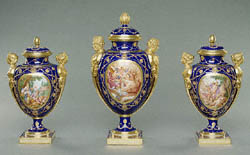These vases, produced at the Sèvres Porcelain Manufactory from 1778, are called the Vases des âges (vases of the ages). The decoration of the gilded handles symbolizes the ages of man. The full set was made in three sizes: the largest was set with handles in the form of heads of old men, the second with the heads of young women, and the smallest with the heads of young boys. Among the most lavish porcelains ever produced at Sèvres, these vases were purchased by Louis XVI for his library at Versailles. The two smaller vases that completed this garniture, or arrangement of vases, can now be found in the Walters Art Gallery, Baltimore.
The expensive technique of using stamped gold foils set with colored enamels, imitating jewels, pearls, and moss agates, was used at Sèvres between 1780 and 1785. It was primarily employed in the decoration of cups and saucers that were collected for display rather than use. It is rarely found on larger wares such as these vases.
The painted scenes on the front of the vases are based on engravings illustrating The Adventures of Telemachus by François de Salignac de la Mothe-Fénelon. While little known today, Fénelon's book was the most widely read French literary work of the 18th century. It was written as a pedagogical treatise for the educational curriculum of Louis XIV's grandson, the Duke of Burgundy. Based on the fourth book of Homer's Odyssey, the story follows Telemachus, son of Odysseus, on a quest to find his father. Telemachus is accompanied on his quest by Mentor, who is also the goddess Minerva. She, along with other characters, provide moral and civic instruction. The scene on this vase shows Minerva protecting Telemachus from the darts of Cupid, who seeks to hinder the youth on his quest by making him fall in love.
About the Sèvres Manufactory
In 1756 the porcelain manufactory that had been founded at Vincennes was transferred to the town of Sèvres. Three years later, the king, Louis XV, became the principal shareholder and financial backer and had the factory designated the "Royal Porcelain Manufactory." The factory thus came under the control of the royal administration and focused on manufacturing luxury porcelain mainly for the royal family, the court, and the aristocracy.
Hard-paste porcelain was not made at Sèvres until the late 1760s, when deposits of the vital ingredient kaolin (a fine white clay originally found in China and used to produce Chinese porcelain) were found near Limoges, France. Until that time, Sèvres produced wares of soft-paste porcelain. Numerous artists collaborated in the production of a single piece of porcelain, and many left their personal identification marks incised in the paste or painted over the glaze. In addition to the marks of individual craftsmen, Sèvres wares carry marks identifying them as products of the royal manufactory. Soft-paste porcelain was marked with painted crossed L's enclosing a date-letter: A indicating 1753, B for 1754, and so on. When the alphabet had been exhausted in 1777, it was begun again using double letters. Hard-paste porcelain was marked in the same way, with the addition of a small crown above the crossed L's.
About Porcelain
Porcelain is a type of ceramics highly valued for its beauty and strength. It is often called china, or chinaware, because it was first made in China. Porcelain is characterized by whiteness, a delicate appearance, and translucence (the ability to let light shine through). Porcelain is used for electrical insulators and laboratory equipment. However, porcelain is known primarily as a material for high-quality vases and tableware, as well as for figurines and other decorative objects.
Porcelain differs from other types of ceramics in its ingredients and in the process by which it is produced. Two common types of ceramics—earthenware and stoneware—are made from a single natural clay, which is then fired (baked). In many cases, the object is coated with a glassy substance called glaze. Firing at a low temperature produces earthenware, a porous material. Earthenware can be made waterproof by glazing. Firing at a high temperature produces stoneware, a hard, heavy material. Without glazing, stoneware is nonporous.
Unlike earthenware and stoneware, porcelain is basically made from a mixture of two ingredients: kaolin and petuntse. Kaolin is a fine white clay that results from the decomposition of feldspar. The French word kaolin comes from the Chinese word Kao-ling, the name of the mountain in northern China where this material was originally obtained. Petuntse is a coarse clay—the word means "little white bricks" in Chinese. To make porcelain, the petuntse is ground to a fine powder and mixed with kaolin. This mixture is then fired at temperatures from about 2280 °F (1250 °C) to 2640 °F (1450 °C). At these extreme temperatures, the petuntse vitrifies, or melts, forming a nonporous, natural glass. The kaolin, which is highly resistant to heat, does not melt and therefore allows the item to hold its shape. The process is complete when the petuntse fuses itself to the kaolin.
|
